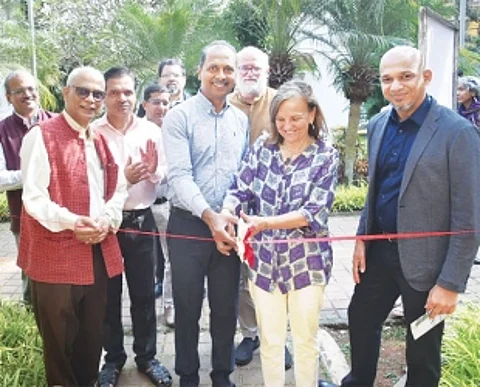

Walk into the Art Gallery at Maquinez Palace in Panjim and it feels like opening a time capsule. With images and maps from dating back centuries, ‘Uniqueness of Goan Architecture’, an exhibition curated by architect Dr Vishvesh Kandolkar, leaves one in awe of the old cities and how they look now. The master planners had given so much thought for different aspect of city life that it is quite a wonder that these cities still rely on these resources.
Goa College of Architecture and Directorate of Technical
Education have organised the exhibition, ‘Uniqueness of Goan Architecture’
which is supported by the International Lusophone Festival in Goa and will be
on display at the Art Gallery, Maquinez Palace, Panjim, till today, December 6.
The Ministry of External Affairs of India in collaboration with Government of
Goa, is currently organising the International Lusophone Festival in Goa. The
exhibition is curated by Dr Vishvesh, who also focused on his research on Old
Goa and Panjim, and architects who hugely contributed to the exhibition include
Prof Dr Ashish K Rege, Neelesh Juwarkar, Noah Fernandes, Ganga Chari, Carissa
Silveira George, Amey Korgaonkar, Rita Vaz, Shifa Bi Khan and Vibhavari
Shirodkar. The brochure which encapsulates this exhibition is designed by
architect Pradnya Bhave.
“The exhibition portrays the diversity of Goan architecture,
encompassing themes such as forts, houses, religious architecture, and city
architecture, including urban history of Old Goa, Mapusa, Margao, and Panjim.
The exhibition is based on works done by faculty and students of Goa College of
Architecture, with documentation from GCA Library and archival images from the
Goa Central Library,” says Vishvesh Kandolkar, a senior faculty member at Goa
College of Architecture, Panjim.
From the Dhangar communities in Canacona and Quepem which are
documented by Noah Fernandes in 2010 as his final year dissertation, to the
development of cities like Mapusa and Margao, the exhibition is also a
mythbuster for legends about the structures in Goa. “The exhibition showcases
some of the oldest maps of Old Goa, which tell the story of the city prosperity
in the sixteenth century and its eventual downfall. The maps are accompanied by
19th century photographs of Old Goa by Souza and Paul. The city of Old Goa was
affected by not just the epidemic but the coming of the Dutch and the British
where the trade moved to other parts of the country. Many things happened for
the downfall of Old Goa. The oldest pictures of the Bom Jesus Church shows the
church without the arches and the plastered and painted exteriors. In 1859, one
of the biggest expositions was held and in 1862, the arches were built. In
1952, the plaster was removed to show that it was a very old building just
before the 1952 exposition,” explains Vishvesh. The oldest Map of Ilhas by
Pedro Barretto de Resende in 1646, can be obtained if the British Library Board
is credited for the image.
Macazana-based
architect-researcher Rita Vaz, highlights the makeshift vernacular architecture
of tiatr. “The stage is important for the tiatr and in some places it is even
constructed between two buildings. The diversity of Goan architecture not
simply in the houses of Goa,” says Vishvesh. The exhibition also focuses on the
temple and mosque architecture which is very unique even in the entire country.